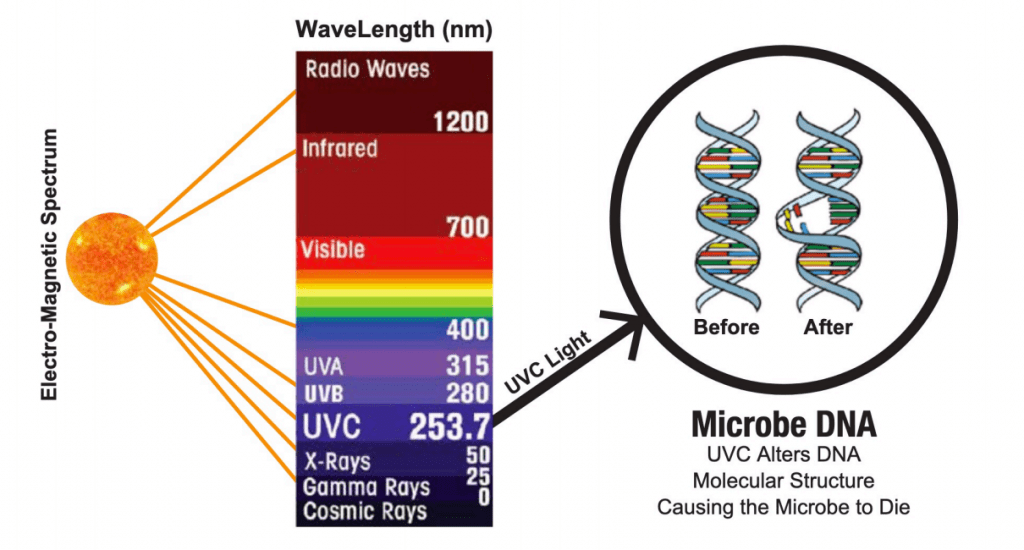KNOWLEDGEMENT
KNOWLEDGEMENT

General knowledge about UVC

UV-C, or germicidal UV
UV-C is a wavelength of UV light, typically between 200 to 313 nanometers, that can inactivate pathogens like bacteria and viruses. UV-C light, in the right strength and dose, modifies the DNA structure of an infectious cell so it cannot reproduce and therefore cannot colonize and spread. UV radiant energy was first used for disinfecting surfaces in 1877 and has since been used extensively, in disinfecting drinking water, wastewater, air, pharmaceutical products, and surfaces against a whole suite of human pathogens. UV-C has been used in hospitals and healthcare facilities for decades and is proven to be effective in both the reduction of hygiene failures and in control environmental contamination by high-concern microorganisms, such as COVID-19. Similar to UV-A and UV-B rays from the sun, exposure to UV-C can damage eyes and skin if overly exposed, so it is essential to follow the strict safety guidelines when UV-C devices are in use.
The high energy from short wavelength UV-C light is absorbed in the cellular RNA and DNA, damaging nucleic acids and preventing microorganisms from infecting and reproducing. This results in virus inactivation, such that they are no longer able to replicate. The amount of inactivation is directly proportional to the UV-C dose, which is received, and this, in turn, is the result of its intensity and duration of exposure.

How does UV light kill germs?
The most efficient source for generating UV-C is the low-pressure mercury discharge lamp, where on average 35% of input watts is converted to UV-C watts. UV-C radiations can deteriorate the external surface of some polymers, plastics and rubbers according to the length of exposure. A reiterated exposure to UV-C disinfection radiation could cause surface brittle and color fading of certain composite materials. This effect is similar to the one produced by prolonged exposure to direct sun radiation.

UV radiation is classified
into three different wavebands that have somewhat different biological effects:
UVA
315 and 400 nm – waveband most associated with skin aging; can cause other effects depending on the dose received and the presence of any photosensitizer.
UVB
280 to 315 nm – waveband most associated with sunburn, skin cancer and cataracts.
UVC
100 to 280 nm – called ‘germicidal’ radiation because of its ability to kill bacteria and inactivate viruses. UVC can cause injury to the skin (e.g. erythema, also known as sunburn) and eye (i.e. inflammation of the cornea or photokeratitis). Solar UVC is blocked by the ozone layer in the atmosphere, so does not reach the earth.
How does UV light kill germs?
The most efficient source for generating UV-C is the low-pressure mercury discharge lamp, where on average 35% of input watts is converted to UV-C watts. UV-C radiations can deteriorate the external surface of some polymers, plastics and rubbers according to the length of exposure. A reiterated exposure to UV-C disinfection radiation could cause surface brittle and color fading of certain composite materials. This effect is similar to the one produced by prolonged exposure to direct sun radiation.


UV radiation is classified
Into three different wavebands that have somewhat different biological effects:
UVA
315 and 400 nm – waveband most associated with skin aging; can cause other effects depending on the dose received and the presence of any photosensitizer
UVB
280 to 315 nm – waveband most associated with sunburn, skin cancer and cataracts.
UVC
100 to 280 nm – called ‘germicidal’ radiation because of its ability to kill bacteria and inactivate viruses. UVC can cause injury to the skin (e.g. erythema, also known as sunburn) and eye (i.e. inflammation of the cornea or photokeratitis). Solar UVC is blocked by the ozone layer in the atmosphere, so does not reach the earth

